by Winding Pathways | Mar 13, 2016 | Amphibians/Reptiles, Birds, Nature, Travel/Columns
After an unusually mild winter we were hardly surprised by the early onset of spring’s symphony. At Winding Pathways in Iowa it usually starts on clear cold February days when male cardinals begin their beeker beeker beeker call. They were close to their normal schedule this late winter. Then red winged blackbirds arrived fully two weeks early and added their voices to roadside ditches and wetlands.
On March 7 we heard the glorious sound that truly harkens spring – Chorus Frogs and Peepers! We were driving a dirt road through southern Iowa’s Shimek State Forest when Marion heard the voices of dozens of tiny frogs coming from a puddle the size of our car.
Chorus Frogs
To naturalist Joseph Wood Krutch singing peepers heralded a true resurrection and marked the start of the warm season. Living in Connecticut he noted that they always began singing in the period of time in which Easter can fall. In other words between March 22 and April 25 .
That’s usually true in Iowa but this year they are earlier, much earlier.
Most people have heard peepers and chorus frogs but have never seen the tiny amphibians that sing with magnificent enthusiasm. The two species often live in the same places and can be easily told apart by their calls. Chorus frogs sound like a person running his finger along the teeth of a comb, while peepers make the “peep peep peep” calls that gives them their name. To hear recorded peepers and chorus frogs log in to Manitoba Frog and Toad Calls.
Frogs are far from the only animals that begin calling as winter transitions into spring. Migrating birds are already beginning to appear in yards, woodlands, and wetlands across America and often they are easier to hear than see. Some of the most melodic singers are the hardest birds to spot, and identifying them by sound is often more efficient than trying to spot a bird in thick brush. The Cornell Lab of Ornithology has excellent audios of bird calls for mobile apps.
Experienced birders (and froggers for that matter) use both ears and eyes to identify species. Like many birders we started out using printed bird guides to help us learn species. Only much later did we begin learning their calls. It’s been a rewarding hobby that has a cruel catch.
Each Rich would learn new bird calls when history caught up with him. Probably due to intense noise of heavy machine guns in Army training decades ago his ability to hear many sounds, particularly those of high pitches is fading. Marion can hear birdsong he can’t. He’s investigating hearing aids that should help him continue this fascinating means of identification. Stay tuned. He’ll report on hearing aids later.
USING THE MERLIN APP
For years we lugged around bird books that were either large and heavy or compact but limited in the information they provided. They were the best way to learn new species in the field.
That’s changed thanks to the Cornell Laboratory of Ornithology. We loaded their free Merlin App into our smart phones. It makes identifying 400 bird species a snap. At the touch of a few keys several photos of each species appear, a range map, and……best of all…… recorded sounds of each bird.
We still carry and refer to a paper bird book but the Merlin App has become our favorite field tool for identifying birds, especially by their call.
ABOUT THE LABORATORY OF ORNITHOLOGY
We joined the Lab a few years ago and love its colorful and informative magazine, LIVING BIRD, and the many bird tips posted on their websiteChorus Frogs. The Lab has been a leader in bird science for decades and they’ve helped us become better birders and gain new insights into the lives of these fascinating animals.
by Winding Pathways | Dec 30, 2015 | Birds, Mammals, Nature, Pests
Watching backyard wildlife yields amazing sights and education. We recently noticed two things at Winding Pathways that reminded us about how many animals are downright smart.
Both involved a manufactured trap that supposedly catches House Sparrows. We have more of this pesky bird than we’d like so we set the trap under a feeder and baited it with cracked corn. A few minutes later an intrepid chipmunk entered the trap’s funnel-like door, feasted on seeds, and couldn’t find his way out. We gently released him and set the trap back on the corn.
A few minutes later we were amazed to see the chipmunk back and watch it tunnel under the trap to reach the bait! He’d learned that entering the trap brought trouble and figured out how to safely reach lunch.
Our sparrows are even smarter than the chipmunk. Not a single one entered the trap. Instead they feasted on corn and millet on the ground around the feeder. After a few hours they had eaten all the safe seed but they still wouldn’t enter the trap.
We now have new respect for the intelligence of both chipmunks and House Sparrows.
-
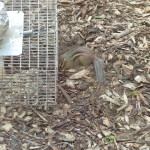
-
The chipmunk figured out how to tunnel under the live trap to reach the corn.
-
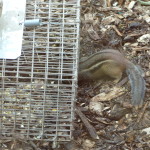
-
Having excavated, the chipmunk now enters the tunnel to get the corn.
-
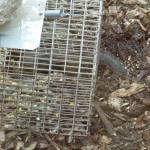
-
In and Under!
-
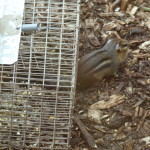
-
With pouches full, the chipmunk emerges.
-
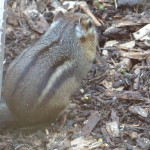
-
The chipmunk figured how to tunnel under the live trap, gather up the corn and emerged with pouches full.
by Winding Pathways | Dec 25, 2015 | Birds, Nature

De-light the tree if you must and adorn it with seed for greater natural delights!
After the holiday cheer fades and ornaments are stored away the Christmas tree can enjoy a second life alive with birds.
Nothing makes a better bird feeder than an upright fir. We take our old tree outside and set it upright. We either use the stand to hold it, dig a hole in the ground deep enough to hold the tree upright, or pound a tall stake into the ground and tie the tree to it. A few strings going out to stakes in the ground will keep it standing in high wind.
Then the fun starts. We pour a couple of cups of birdseed on the very top of the tree and let it settle down into the needles. Larger seeds, like peanuts and gray striped sunflower, work best.
So many birds flock to our tree to find seeds within its branches that it quivers with life and color.
Good sources of seeds include your local feed and wild bird stores, Amazon, Kaytee Products, and Pine Tree Farms, Inc, and of course, many others.
by Winding Pathways | Dec 19, 2015 | Birds, Nature
Christmas trees bring Holiday spirit to a home but come at a cost. We love balsam firs for their beauty and wonderful fragrance, but we don’t fancy sweeping up needles as the drying tree sheds.
This year we found the solution. We set the fir up on the deck just outside our living room. A large window gives great viewing and several strings keep it upright on windy days. Instead of normal decorations we bought several bell shaped pressed seeds, a thistle sock, and some small feeders and decorated the tree for the birds. Each morning we pour peanuts and sunflower seed at the tree’s top and many seeds settle on branches.
Our tree is alive with birds and squirrels all day. They are our living ornaments. And, after the Christmas season is over all we need to do is untie the strings, remove the tree from the stand, and sweep the deck off.
Marion and Rich at Winding Pathways wish you a pleasant winter holiday and a happy and healthy 2016.
PUTTING THE OLD TREE TO USE
Winding Pathways is near Cedar Rapids, Iowa where Indian Creek Nature Center accepts donated Christmas trees in January. They are chipped and volunteers spread the aromatic chips on trails. A walk on a freshly chipped trail smells like the north woods stroll.
Many other nature centers and towns recycle trees, but they can also be used around the home. Clip off the branches, let them dry and needles fall, and make kindling from the branches for summer cookouts. The stem makes a great garden pole. Set it upright and plant a few pole bean seeds in May. By July the tree will support delicious green beans.
-
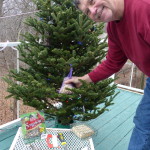
-
Rich bought a variety of bird seed and suet that has been a big hit with wildlife.
-
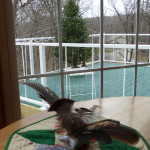
-
From the comfort of the house, we can enjoy the animal antics.
-
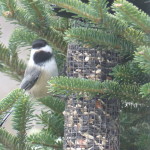
-
Checking out the treats!
-
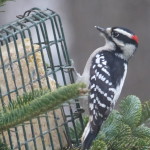
-
Ready to feed.
-
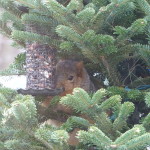
-
The squirrels quickly find that hiding among the branches gives them protection from the wind, predators and excellent vantage for eating!
by Winding Pathways | Nov 28, 2015 | Birds, Children/Play, Labyrinths, Nature, Travel/Columns, Wonderment
-
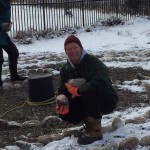
-
Lisa organizing the build.
-
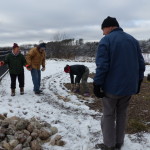
-
Hudson, WI, has a new labyrinth at Healing Waters Health Center. Created by Lisa Gidlow Moriarty and assisted by several volunteers.
-
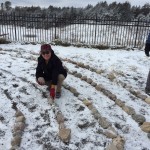
-
Carefully laying stone in the new labyrinth
What fortune to have contacted Lisa Gidlow Moriarty who was constructing a labyirnth at Healing Waters Health Center in Hudson, WI. Rich and I joined the crew and after the lines were drawn using high technology of a bucket and rope and a tire iron to gouge the circuits, we placed rocks that had been hauled in. The concentric circuits quickly asserted themselves and the labyirnth was completed in no time at all! The day was cold, but the hearts and spirits warm. What a fun experience.
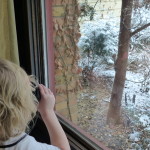
The children are quick to spot birds and squirrels.
Time with extended family in the Twin Cities was restful and hilarious as the children explored outside, spotted birds with “noculators”, and constructed wonderful toys from Legos.
Thanksgiving morning four of us walked a lovely labyrinth at St. Patrick’s Catholic Church in Plymouth, MN. Set down in a barrow area, the labyrinth is formal, well-maintained and has a light feel to it. While set apart, it is visible and still private. Well done.
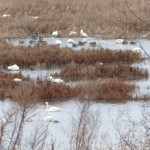
Along the Mississippi
Our drive back along the Mississippi River yielded a fabulous view of Tundra Swans near Minneiska, MN, and a really terrific lunch at a humble looking (on the outside) but spectacular on the inside creamery now restaurant, wine tasting stop and cheesery near Alma, WI. Pretty fabulous. And, the countryside of The Driftless” area (NE Iowa, NW IL, SE MN and SW WI) is gorgeous even on grey November days. Decorah, IA, boasts are pretty great coffee shop and small businesses.
by Winding Pathways | Nov 24, 2015 | Birds, Chickens, Nature
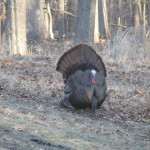
Strutting his stuff
As we enjoy Thanksgiving dinner we pay homage to the great gift the Americas gave the world.
Beef, pork, lamb, and chicken all come from animals with Old World origins. Shortly after Europeans discovered North and South America, Australia, New Zealand, and other new worlds they introduced these familiar and useful farm animals. Before Columbus made landfall, Native Americans knew nothing about these exotic animals. But, they knew turkeys.
Of all common meat animals eaten today only turkeys came from the New World. Before Columbus, wild turkeys abounded across much of North America. Their domestic cousins were tended by some tribes. Treated with great care, the domesticated turkeys were an important source of clothing, tools and food. Among some uses of the tribes of the Four Corners of the United States, turkeys provided feathers for coats, eggs for eating and reproduction, and bones for tools. Evidence exists that the Native Americans cross bred for certain valued characteristics. Europeans quickly developed a taste for turkey and brought them eastward across the Atlantic where they became a common European food.
Our Thanksgiving dinner consists of turkey, potatoes, and winter squash, all Native American foods. Sometimes we add acorn muffins and capstone the meal with a long time family recipe for pumpkin pie, made from a plant that also originated here.

















